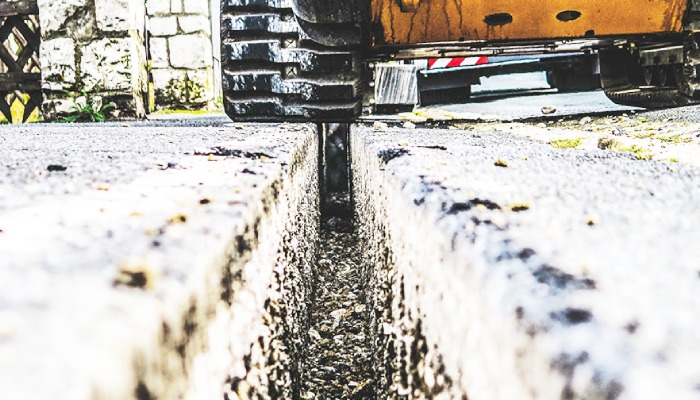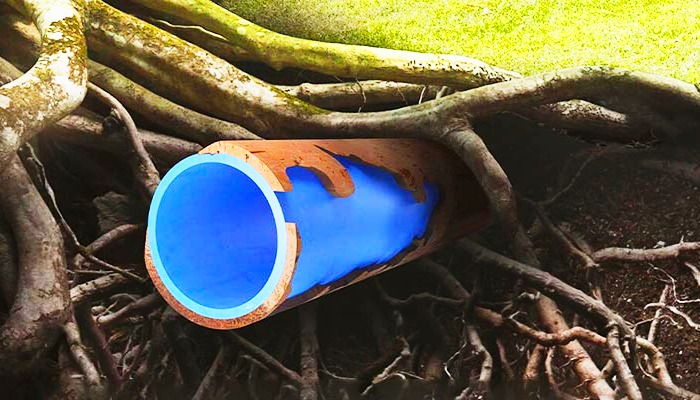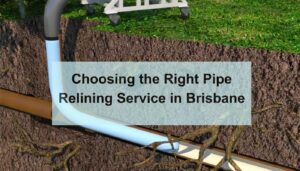In an era where environmental conservation is not just a preference but a necessity, the construction and maintenance of urban infrastructure are undergoing significant transformations. Among these, no-dig pipe repair technologies, also known as trenchless technology, represent a groundbreaking shift towards more sustainable urban development. This innovative approach to repairing and replacing underground pipes, including sewer pipes and underground PVC pipes, minimizes the need for extensive excavation, offering a greener alternative to traditional dig-and-replace methods. Unlike traditional pipe repair methods that often require extensive excavation and digging up the existing damaged pipe, no-dig technologies allow for the repair of underground PVC pipe without digging, significantly reducing the impact on the environment.
The environmental impact of construction activities has long been a concern for ecologists, urban planners, and the public alike. Traditional methods of pipe repair, involving extensive digging, not only disrupt the urban landscape but also contribute significantly to carbon emissions, waste production, and the disturbance of ecosystems. In contrast, no-dig technologies offer a solution that reduces these impacts dramatically, marking a pivotal step towards reducing the carbon footprint of infrastructure maintenance.
This article delves into the environmental benefits of no-dig pipe repair technologies, exploring how they conserve natural resources, protect ecosystems, and offer a sustainable alternative to traditional construction practices. By examining the rise of these technologies, their advantages, and the challenges they face, we shed light on their role in fostering sustainable urban environments. As cities continue to grow, and the pressure on natural resources increases, the adoption of environmentally friendly repair methods like no-dig technologies becomes crucial in our quest for sustainability.
The Rise of No-Dig Technologies

No-dig pipe repair technologies, a cornerstone of modern urban infrastructure maintenance, have revolutionized the way we approach the repair and replacement of underground utilities, including the ability to repair underground PVC pipe without digging. This section traces the evolution from traditional excavation methods to today’s trenchless solutions, highlighting the technological advancements and increased adoption over time.
By enabling repairs beneath the surface with minimal disruption, these innovations not only streamline maintenance processes but also significantly mitigate environmental impact, illustrating a major shift towards more sustainable practices in managing urban infrastructure.
Historical Context
The inception of no-dig technologies dates back to the 1970s, with the development of methods like Cured-in-Place Pipe (CIPP) and Horizontal Directional Drilling (HDD). These methods were born out of a necessity to minimize the disruption caused by utility repairs in densely populated areas and sensitive environmental zones. Over the decades, advancements in technology and materials have refined these techniques, making them more efficient, reliable, and applicable to a wider range of scenarios.
Overview of No-Dig Technologies
Key no-dig methods include:
- Cured-in-Place Pipe (CIPP): A method where a resin-saturated felt tube is inserted into the existing pipe and cured to form a new pipe within the old one, without the need for excavation.
- Pipe Bursting: A technique where a new pipe is pulled through the old one, simultaneously breaking the old pipe and replacing it with the new pipe.
- Horizontal Directional Drilling (HDD): A method used for installing underground pipes, conduits, or cables along a predetermined path using a surface-launched drilling rig, with minimal impact on the surrounding area.
Benefits Over Traditional Methods

The shift towards no-dig technologies is driven by their numerous advantages over traditional dig-and-replace methods, including:
- Reduced Surface Disruption: No-dig methods significantly minimize the disturbance to roadways, landscapes, and communities, preserving the urban fabric and reducing the need for costly restorations.
- Efficiency and Cost-Effectiveness: These technologies often allow repairs to be completed more quickly and with less labor, translating into lower overall costs.
- Environmental Benefits: By reducing the need for excavation, no-dig methods lessen the environmental impact associated with traditional pipe repair, including reduced carbon emissions, less disruption to ecosystems, and lower volumes of excavated waste.
As urban areas continue to expand and the demand for sustainable infrastructure solutions grows, the rise of no-dig technologies represents a crucial development in our approach to environmental conservation and urban planning. This evolution not only reflects technological advancement but also a growing recognition of the need to balance development with environmental stewardship.
Environmental Benefits of No-Dig Pipe Repair
The adoption of no-dig pipe repair technologies, including pipe relining, marks a significant stride toward environmental sustainability in the construction and maintenance of urban infrastructure. These trenchless pipe repair methods offer a myriad of environmental benefits, ranging from reduced carbon emissions to the conservation of ecosystems, which collectively contribute to a more sustainable future.
Pipe relining, a key technique within no-dig technologies, involves repairing damaged pipes by inserting a new lining inside the existing pipe, effectively creating a new, durable pipe within the old one without the need for extensive excavation.
This section explores the key environmental advantages of employing no-dig technologies, including the innovative approach of pipe relining, highlighting how these methods not only address infrastructure needs but also significantly reduce the environmental footprint of such activities.
Reduction in Carbon Footprint

One of the most compelling environmental benefits of no-dig technologies is the substantial reduction in carbon emissions. Traditional excavation methods rely heavily on the use of large, diesel-powered machinery that emits significant amounts of carbon dioxide and other greenhouse gases. In contrast, no-dig methods require less equipment and energy, leading to lower greenhouse gas emissions too. Moreover, the decreased need for transportation of materials to and from the site further reduces the carbon footprint associated with pipe repairs and replacements.
Conservation of Landscapes and Ecosystems
No-dig technologies have a minimal impact on the physical environment compared to traditional methods. Traditional excavation can disrupt local ecosystems, damage root systems of trees, and lead to soil erosion and compaction. Trenchless methods, by minimal excavation and avoiding extensive digging, preserve the integrity of landscapes and ecosystems. This is particularly important in sensitive areas, such as wetlands, parks, and regions with endangered species, where maintaining ecological balance is crucial.
Reduced Waste Generation
Trenchless pipe repair methods generate significantly less waste than traditional excavation. With no-dig techniques, there is no need to remove large amounts of soil or dispose of old piping materials excavated from the ground. This not only reduces the strain on landfills but also decreases the environmental impact associated with waste transportation and disposal. Moreover, methods like CIPP make use of the same existing pipes and pipeline structure to create a new pipe, further minimizing waste.
Water Conservation
No-dig technologies also contribute to water conservation. Traditional repair methods often require dewatering of the work area, leading to significant water use and potential contamination of local water bodies. Trenchless methods, on the other hand, eliminate the need for dewatering, thereby conserving water resources and protecting water quality.
Case Studies and Real-World Applications

The environmental benefits of no-dig technologies are not merely theoretical; they have been demonstrated in numerous real-world applications across the globe. This section highlights several case studies where trenchless methods have been successfully implemented, showcasing their environmental advantages and practical benefits.
Urban Waterway Protection in Europe
In one European city, a Cured-in-Place Pipe (CIPP) method was used to repair aging sewer lines running beneath a protected urban waterway. The traditional method would have required extensive excavation, disrupting the waterway and surrounding parkland. The no-dig approach allowed the project to be completed without disturbing the aquatic ecosystem, preventing potential water pollution and preserving the natural landscape.
Infrastructure Upgrade in a Dense Urban Area
A major city in North America utilized horizontal directional drilling (HDD) to upgrade its telecommunications infrastructure without disrupting the bustling urban environment. This project avoided the need to open trenches along busy streets, significantly reducing carbon emissions from traffic congestion and machinery. Additionally, the approach minimized noise pollution and public inconvenience, highlighting the societal benefits of no-dig technologies.
Rural Water Supply Enhancement
In a rural area, pipe bursting was employed to replace an old water supply line without disturbing the agricultural land. Traditional excavation would have impacted the fertile soil and disrupted farming activities. The trenchless method durable pipe, ensured that agricultural operations could continue without interruption, preserving soil integrity and preventing erosion.
These case studies illustrate the versatility and effectiveness of no-dig technologies in various settings, from urban centers to rural landscapes. By reducing environmental impact and preserving the integrity of ecosystems, no-dig methods offer a sustainable solution to the challenges of maintaining and upgrading infrastructure in the 21st century. The success of these projects serves as a testament to the potential of trenchless technologies to contribute to environmental conservation while meeting the demands of modern infrastructure maintenance.
Challenges and Limitations

While no-dig pipe and sewer line repair technologies offer significant environmental and operational benefits, they are not without their challenges and limitations. Understanding these hurdles is crucial for furthering the adoption of trenchless methods and for developing solutions that address these issues effectively.
Technical Constraints
One of the primary challenges associated with no-dig technologies is their technical limitations. Certain ground conditions, such as rocky soil or extreme variability in soil composition, can pose difficulties for trenchless repairs. Additionally, the existing infrastructure layout, including the proximity of utility lines damaged pipes and the condition of the pipes, may limit the applicability of no-dig methods. For instance, severely collapsed pipes might not be suitable for Cured-in-Place Pipe (CIPP) repairs, requiring alternative solutions.
Environmental Concerns
Despite their environmental advantages, no-dig technologies can also pose certain environmental risks. The use of chemicals, particularly in the CIPP process, has raised concerns regarding potential leaching into surrounding soil and water bodies. Ensuring the safe handling and disposal of these materials is critical to mitigate environmental impact.
Cost Considerations
The initial investment for no-dig technologies can be higher than traditional methods, particularly for projects requiring specialized equipment or materials. Although the long-term cost savings, including reduced repair times and restoration costs and minimized disruption, can offset these initial expenses, the upfront costs can be a barrier for some municipalities or utility providers.
Knowledge and Skill Gaps
The successful implementation of no-dig technologies requires specialized knowledge and skills. There is a learning curve associated with adopting these methods, and a lack of trained professionals can hinder their broader application. Increasing training opportunities and promoting knowledge sharing within the industry are essential steps toward overcoming this challenge.
Future Directions and Innovations

The future of no-dig pipe repair technologies is bright, with ongoing research and development focusing on overcoming existing challenges and enhancing the environmental and operational benefits. Innovations in materials, techniques, and equipment are paving the way for wider adoption and more efficient implementations.
Advanced Materials and Methods
Research into new materials and repair methods promises to expand the applicability of no-dig technologies. For instance, the development of more environmentally friendly resins and liners for CIPP repairs can mitigate concerns about chemical use. Additionally, advancements in robotics and automation are enabling more precise and efficient repair processes, reducing the potential for errors and further minimizing environmental impact.
Improved Detection and Diagnosis Tools
Innovations in detection and diagnostic tools are crucial for identifying the need for repairs and for planning no-dig interventions. Technologies such as ground-penetrating radar (GPR) and advanced imaging techniques can provide detailed insights into pipe conditions and surrounding soil structures, allowing for more targeted and cost effective repairs.
Sustainability and Lifecycle Considerations
The integration of lifecycle assessment (LCA) methodologies into the planning and execution of no-dig projects is an emerging trend. By considering the environmental impact of repair methods over the entire lifecycle of the infrastructure, decision-makers can choose the most sustainable options. This holistic approach encourages the selection of methods that not only address immediate repair needs but also contribute to long-term environmental goals.
Collaboration and Standardization
Efforts to standardize practices and promote collaboration across the industry can accelerate the adoption of no-dig, sewer repair technologies. Establishing common standards for materials, procedures, and training can ensure the quality and consistency of trenchless repairs. Moreover, fostering partnerships between municipalities, utility providers, and technology developers can facilitate knowledge exchange and drive innovation.
As no-dig technologies continue to evolve, their role in promoting sustainable urban development and environmental protection and conservation is set to increase. By addressing current challenges and harnessing the potential of future innovations, trenchless methods can offer effective, efficient, and environmentally friendly solutions for maintaining and upgrading underground infrastructure.
Policy and Regulatory Framework

The implementation and success of no-dig pipe repair technologies are significantly influenced by the policy and regulatory framework within which they operate. Governments and regulatory bodies play a crucial role in promoting the use of trenchless pipe and methods through legislation, guidelines, and incentives that prioritize environmental sustainability and efficient infrastructure management.
Supportive Legislation
Legislation that encourages or mandates the use of environmentally friendly and minimally invasive construction over traditional trenching methods, can drive the adoption of no-dig technologies. Some regions have introduced laws that require the consideration of trenchless methods in public infrastructure projects, especially in ecologically sensitive areas or urban centers where traditional excavation would cause significant disruption.
Environmental Regulations
Environmental regulations are critical in ensuring that no-dig technologies are used in a way that protects natural resources and public health. These regulations may pertain to the management of waste materials, the control of emissions during repair works, and the prevention of chemical leachates into the environment. Compliance with these regulations not only mitigates potential environmental impacts but also reinforces the sustainability credentials of no-dig methods.
Financial Incentives
Financial incentives, such as grants, tax breaks, and subsidies for the use of trenchless technologies, can offset the initial costs associated with adopting these methods. Such incentives make no-dig technologies more accessible to municipalities and utility companies, especially for those facing budget constraints.
Standardization and Certification
The development of industry standards and certification programs for no-dig technologies ensures quality and reliability in trenchless repairs. Standardization can facilitate the training of professionals, the evaluation of technologies, and the comparison of methods, contributing to higher adoption rates and successful outcomes.
Conclusion

No-dig pipe repair technologies represent a vital advancement in the pursuit of sustainable urban infrastructure maintenance. By offering a range of environmental benefits, from reduced carbon emissions to the conservation of ecosystems, these methods align closely with global sustainability goals. Despite facing challenges such as technical limitations, environmental concerns, cost considerations, and the need for specialized skills, the future of no-dig technologies is promising. Innovations in materials, methods, and diagnostics, alongside supportive policy and regulatory frameworks, are paving the way for broader adoption and more effective implementations.
As cities around the world continue to grow and the pressure on urban infrastructure intensifies, the importance of adopting sustainable repair and maintenance solutions becomes increasingly clear. No-dig technologies not only offer a practical alternative to traditional excavation but also exemplify how innovation can drive environmental stewardship in the construction industry. By embracing these technologies, stakeholders across the board can contribute to the creation of resilient, efficient, and sustainable urban environments for future generations.








